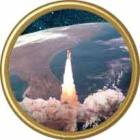1
Welcome to theNASA's Launch Pads
- Josh Simpson story
2
Claybank refractory brick was used in the lower levels of 30' thick Launch Pads for moon shots.1978
Other

3
NASA's Launch PadsBy Josh Simpson
I am now a glassblower (www.megaplanet.com) but I began my career as a potter in 1970. My wife, Cady Coleman was selected as a NASA astronaut in 1992 and made her first shuttle flight on STS-73 aboard Columbia in October, 1995. STS-73 was plagued by a series of delays, mechanical, weather, - you name it - for almost a month. During that time Cady and I had basically nothing to do but wait - so every afternoon and evening we'd go out exploring. As she was a member of the prime crew, we were allowed to wander just about anywhere at NASA we wanted. Visiting some of the old launch pads was exciting, some totally overgrown with vegetation, we felt a bit like archaeologists coming upon some sort of ancient temple. Only rusted steel and cement pillars where rockets once left the earth.
I was intrigued by the firebrick that the launch pads are constructed from. It was laid tightly in a large circle around what remained of the superstructure. One hundred feet from the centre, the brick looked reasonably new (except for the green algae where water puddle). At one site I could easily read the name "Clipper" - one of AP Green Company's high duty brands. At the centre and then outwards for about forty feet the bricks were glazed smooth as if they had been inside a high temperature kiln for countless firings. Directly under where the launch superstructure had been the glass-like glaze was a green brown colour, probably because the bricks had melted to a greater depth at that point. Launch pads 39A and B are now used for shuttle launches. It appears that they use castables or gunnable refractories. There are distinct blast patterns in the refractory where the three liquid hydrogen/oxygen main shuttle engines impinge from at least 50 - 60 feet above. There are also two areas of erosion where the two solid rocket flames come into contact with the firebrick. I could see areas where the refractory bricks melted and puddled, and then ran downward toward the pit. Even with thousands of gallons of water spraying over the brick (mostly for sound suppression), it is amazing how much heat this area is exposed to for just the few seconds between main engine ignition and lift off. NASA also has a huge steel plate that is moved into place on a railroad track to protect the launch structure from the rockets. The steel is totally warped and melted - clearly inferior to the brick!
------------------------------------------------------------------
Note: AP Green Refractories Ltd. owned the Claybank Brick Plant for its last 30 years in business. Claybank brick was likely used in the construction of the above-mentioned launch pads.

